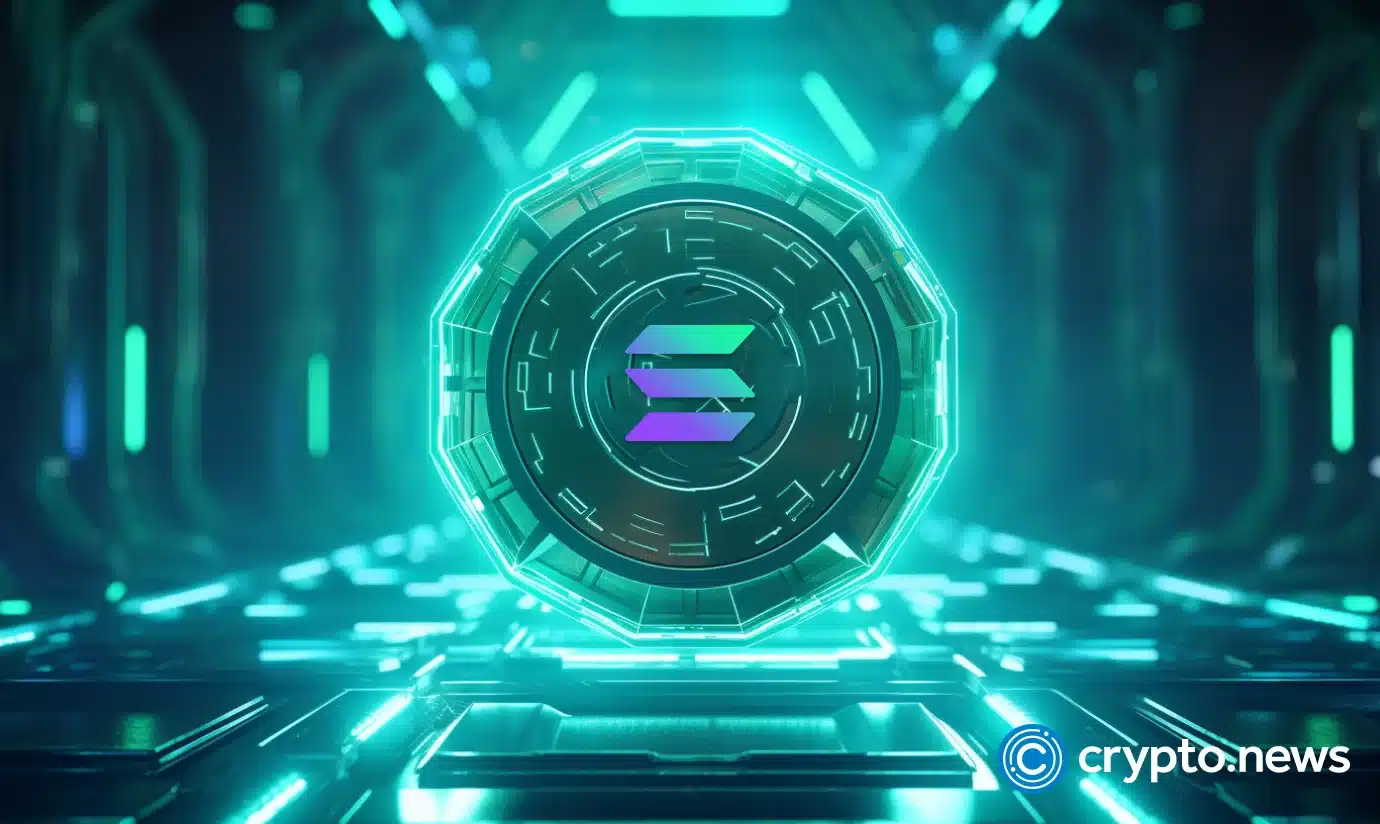
With $500 billion in volume and counting, 1inch sat down with crypto.news to explain how interoperability is being deployed to offer non-custodial solutions to everything from real-world assets to cryptocurrency.
Decentralized exchange (DEX) aggregators seem to be all the rage in DeFi today.
These entities, which source liquidity from multiple DEXs to optimize trading conditions, aim to bolster prices for consumers by lowering fees and reducing slippage.
According to recent data, total trading value of DEX aggregators has grown to $2.03 billion as of February 2025. It is a sector in crypto that many are eyeing for future growth.
One of these DEX aggregators, 1inch, sat down with crypto.news on the sidelines of Paris Blockchain Week to discuss the challenges and opportunities for DEX aggregators in the current crypto cycle.
1inch, a leading decentralized exchange (DEX) aggregator, was founded in May 2019 by Sergej Kunz and Anton Bukov, two Russian developers who met at a hackathon and turned their knack for optimizing crypto trades into a DeFi powerhouse. The platform now optimizes trades across 400+ liquidity sources on 12 blockchains, processing over $500 billion in volume as of today, with zero withdrawal and gas fees offered by its native Chi token.
Co-founder of 1inch, Sergej Kunz, told crypto.news how the firm is aiming to make the jump from the decentralized finance sector into the crypto space by offering users a seamless cross-chain experience that rivals that of centralized exchanges, with a strong focus in the next quarter on DeFi growth and backing entities like Bitcoin and Solana, better UX, and features that aim to bolster and leverage AI, with the goal of using this to aggregate media into a seamless technological umbrella a new super-powered 1inch.
“It’s getting better and better. I think we will see in a couple of years a seamless experience like in centralized exchanges with the benefits of non-custody and atomic execution,” said Kunz to crypto.news at a cafe in Paris on April 16.
In the Wild West of DeFi, Atomic execution refers to the process where a transaction is executed in its entirety or not at all, ensuring no partial completion. This guarantees that all parts of a trade, such as swapping tokens across multiple DEXs, occur simultaneously and are only finalized if all conditions (e.g., price and liquidity) are met, preventing losses from failed or partial trades, including MEV bots that sandwich transactions and extract fees from crypto users.
With 1inch, Kunz explained, new features now allow routes to trade through multiple DEXs to optimize pricing, with atomic execution ensuring the entire swap completes as a single, indivisible transaction on the blockchain. If any part fails (e.g., insufficient liquidity), the transaction reverts, and no funds are exchanged.
As a DEX aggregator, 1inch (1INCH) sources liquidity from multiple DEXs to find the most favorable rates for a single trade. The firm uses a smart contract-based system that enables users to swap between tokens and set their desired price.
“We came to the idea that we have this intent-based protocol to just say what they want to get and how it’s going to be executed is the bread of market makers and market traders,” said Kunz.
“We extended this functionality with cross-chain swaps. And now, we are a cross chain marketplace for all users,” he continued.
The total trading value of DEX aggregators was over $2.03 billion as of February 2025, reflecting their growing role in DeFi, while the market capitalization of DEX aggregator coins was $2.5 billion as on January of this year. Top coins include Jupiter, 1inch, and Cetus Protocol, but others are nipping at the heels of these competitors, given the potential for enormous growth if assets like securities are able to be traded on-chain.
To this end, Kunz says that to standout he has launched Fusion+, an advanced upgrade to 1inch’s Swap Engine. The idea with Fusion+ is to create more efficient cross-chain swaps to get better rates through intent based architecture and bridge less technology. The technology aims to connect user to extensively more Web3 liquidity, but also to protect against front-running attacks like MEV with more security features that gets the best price for Chi users.
So far, Fusion+ has facilitated over $200 million in cross-chain trading volume, Kunz says, noting that since its beta launch last September integrations like ZKsync have boosted overall performance and security.
Today, he says that 1inch is prioritizing cross-chain integration in Bitcoin (BTC) and Solana (SOL), with the idea to allow users more interoperability across popular cryptocurrency options. Right now, there are now EVM-compatible solutions for bridging Bitcoin to Ethereum without wrapping the BTC, and this poses several significant hurdles for those wanting to deploy capital cross chain. Integrating these coins, which operate on their own non-EVM blockchain, still presents several technical challenges due to differences in blockchain architecture.
These hurdles limit Bitcoin’s utility in Ethereum’s DeFi ecosystem, where over $100 billion in TVL (as of April 2025) is concentrated in EVM chains. Bitcoin holders face friction when attempting to use BTC in yield farming, lending, or trading on platforms like Aave, Compound, or 1inch. And the reliance on wrapped tokens means BTC remains a secondary asset in DeFi, with most activity centered on Ethereum-native tokens or stablecoins, with developers building cross-chain dApps (e.g., 1inch, as discussed previously) must integrate multiple BTC variants (WBTC, tBTC) or bridges, increasing complexity and maintenance costs.
Still, 1inch also has their sights set on conquering the traditional finance sector by partnering with banks and other financial institutions to deploy DeFi technology and bring more players on-chain. The idea according to Kunz is to open up the floodgates for institutional adoption of cryptocurrency, but in a way that is DeFi native.
“Self custody is our value proposition as well as atomic execution. We plan to expand to TradFi. From our point of view, TradFi needs to adapt for us. It is not us that has to be able to adapt to TradFi, in terms of technology because our technology is unique,” said Kunz.
Kunz also views security as a major hurdle. He explained how the 1inch team is aiming to solve security issues by integrating anti-money laundering procedures and know-your customer procedures, which may open the doors to greater institutional interest.
“We have a service that aggregates other security services who monitor all the wallets who funds, launder funds. And who move funds from central wallets, and we decline the interaction for APIs at 1inch lab for such wallets,” Kunz said of the current security architecture 1inch maintains.
Will 1inch venture into real-world asset tokenization?
With the rise of real-world asset tokenization, Sergej Kunz sees the sector as a natural second step within 1inch’s roadmap for expansion.
In the next five to ten years, he predicts that people will be able to trade traditional stocks and other conventional securities on-chain. Soon, Kunz believes, traders will be able to retain non-custody on these assets in a way that transcends regional boundaries and builds on atomic execution.
According to a recently published joint report by Ripple and BCG, the market size for asset tokenization has the potential to hit $18.9 trillion in 2033. At the moment, the market size for tokenized asset stands at $600 billion, with major expansion predicted by experts who see on-chain, trade-able stocks as the natural evolution of fin-tech.
In light of this potential for major growth, Kunz worries about a lack of secondary markets for tokenization of real-world assets, despite DeFi being a burgeoning sector of the crypto ecosystem, not many advanced secondary markets exist for niche tradable assets.
“There’s no single place where you can wait for the best execution, and that’s where 1inch comes in. That’s what we’re building. The potential is huge.”







